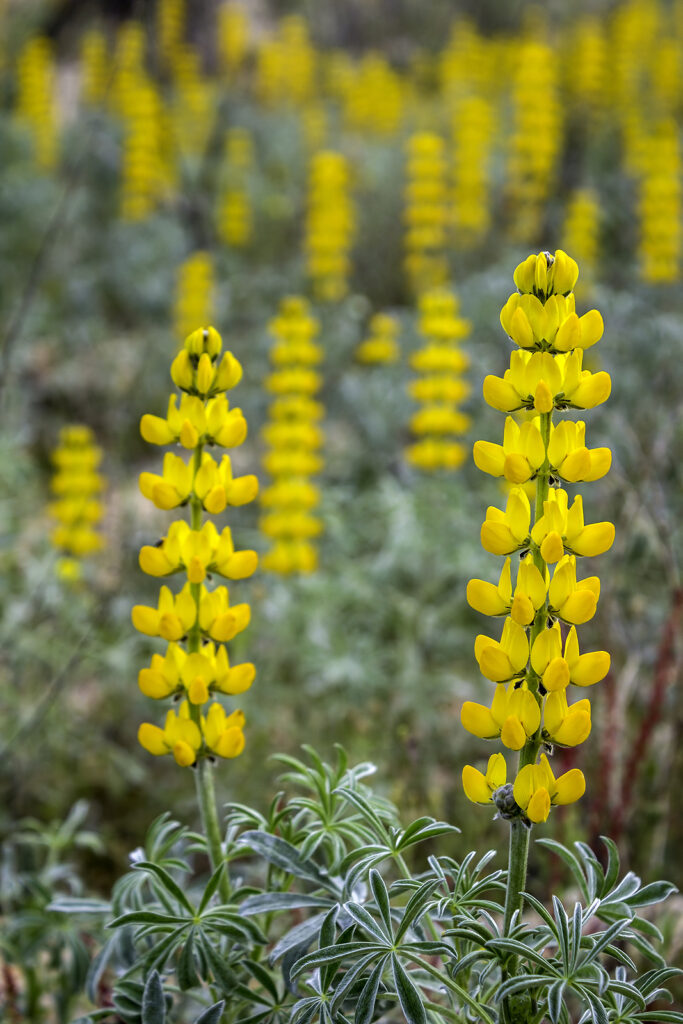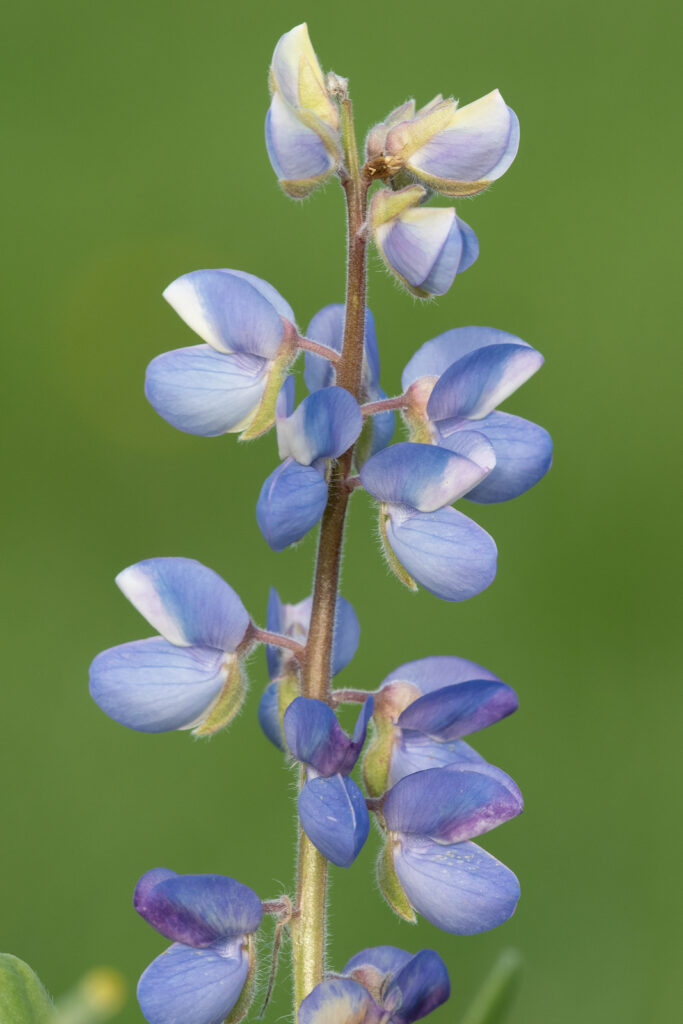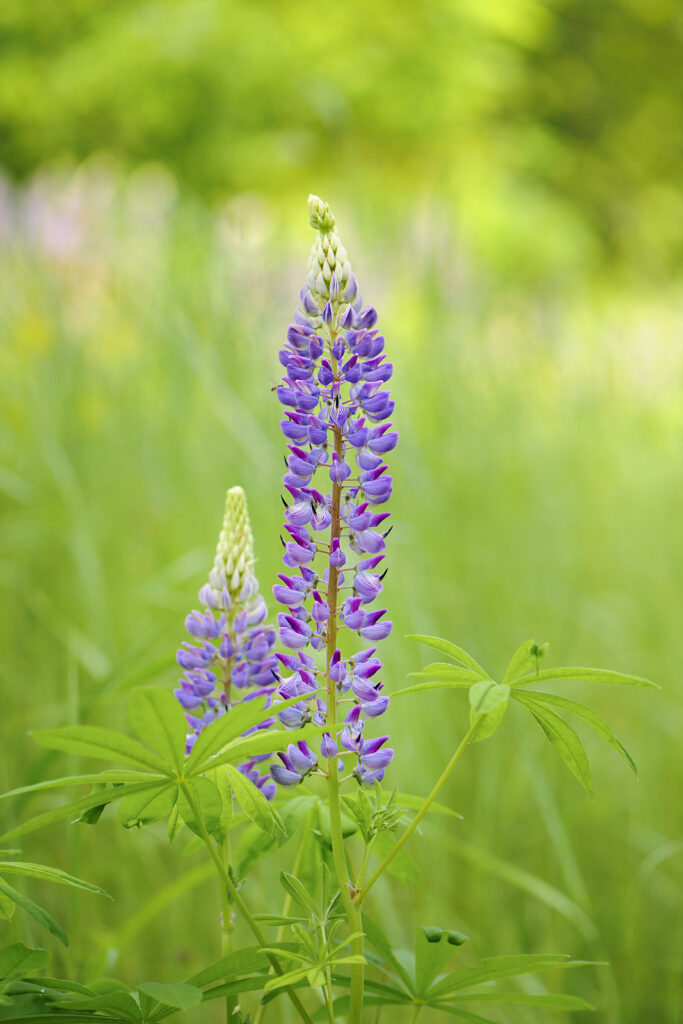Lupinus–commonly called Lupine-bears pea-like blooms in early summer. Lupine forms clumps of divided dark green leaves. Lupine is needs plenty of moisture. It is wind- and cold-tolerant. Lupines are a large group of wildflowers native to western North America.
Lupinus is a genus of annuals and perennials, sometimes shrubs, of the Pea Family. They are grown mostly as ornamentals but some are useful as cover crops or forage crops.
Lupines are distinguished by their deeply cut foliage which has many lance-like rays radiating from the end of the leaf stalk. The flowers are shaped like those of peas and are borne in great profusion on long-stemmed spikes.
The perennials are more popular than the annuals though both are excellent for display purposes. the annual often bloom until late summer and are good in mixed beds and border and also for cutting. The perennials are best when planted in masses.
Lupines generally grow about 3-feet (.9m) tall, thriving in either sun or partial shade. The flowers are predominately blue, yellow, white, or rose; they commonly bloom in late spring and early summer. After the first bloom is over, if the plants are cut back, they will often produce a second showing of flowers.
Lupine propagation is by seed sown in the open where the plants are to grow as they are tap-rooted and resent transplanting. The perennials can be increased by division.

Get to know Lupinus
- Plant type: Perennial or annual
- Growing Zones and range: All zones for wild species; Zones 4 to 6 for garden perennials.
- Hardiness: Garden perennials tolerate temperatures below 0°F (-17°C), but are killed by high heat
- Height and width: 24 to 36 inches (61-91cm) tall; 18 to 24 inches (45-61cm) wide
- Foliage: Leaves resemble in size and shape an outstretched hand; vertical flower spikes cna reach 4 to 5 feet tall
- Flowers: Pea-like blooms on dense, tall stems–flowers appear in racemes
- Flower colors: Blue, purple, pink, red, orange, yellow, cream, white, often bicolored
- Bloom time: Early summer; late spring in Zones 6 and warmer
- Uses: Mass in beds or add to mixed borders
- Garden companions: poppies, peonies, hardy geraniums, bearded iris
- Common name: Lupine
- Botanical name: Lupinus hybrids
- Family: Leguminosae
- Origin: the Mediterranean, North Africa, and North, Central, and South America
Where to plant Lupinus
- Grow lupines in full sun; lupine will tolerate light shade.
- Grow lupines in humus-rich, acidic, well-drained soil.
- Lupines prefer a soil pH of 6 to 6.5.
Lupinus uses and companions
- Mass Lupinus in formal borders or plant as specimens in informal gardens.
- Grow large lupines in a border or wild garden, smaller species in a rock garden or scree bed.
- Good garden companions for Lupinus include Alchemilla mollis, Geranium, Hemerocallis, Iris, Papaver orientale, Thalictrum.

When to plant Lupinus
- Set lupines in the garden in spring in Zones 4-5; plant lupines in fall in Zones 6-9. Plant lupines in groups of 6 or more.
- Start seeds for annual varieties indoors in spring for setting out after the last frost. Start seeds for perennial varieties in spring or summer for setting out before the first fall frost.
Planting and spacing Lupinus
- Start seed as 70° to 80°F (21°-26.7°C). Presoak seeds in tepid water overnight before sowing.
- Sow seeds at 1/4 inch deep.
- Germination take 7 to 14 days. Grow plantlets in a sunny area or a few inches below a fluorescent light fixture. When seedlings have several leaves move them to larger pots.
- Sow seeds outdoors where they will grow in smoothly prepared and fertilized beds.
- Space lupines 6 to 24 inches (15-61cm) apart depending on how dense you want them to grow.
How to water and feed Lupinus
- Lupines want ample moisture; keep the soil evenly moist.
- Water plants often during periods of drought or high heat. Mature plants can thrive in drier soil.
- Keep lupine roots somewhat drier during the winter.
- Fertilize lupines occasionally every 4 to 6 weeks or work a slow-release fertilizer into the soil in spring.
Lupinus care
- Mulch around lupines to conserve soil moisture and to keep the soil cool.
- Trim off spent flower stalks to encourage a second bloom.
- Stake tall plants to keep them from flopping.
- Lupines are susceptible to aphids, powdery mildew, slugs, and crown rot.
Lupinus propagation
- Lupinus seeds germinate in 14-21 days at 65-75°F (18-24°C). Soak seed overnight or scarify to promote germination.
- Divide lumps of crowded perennials when new growth begins in early spring.
- Take cuttings of side shoots growing next to the base of the main stem and root them in moist, shaded beds in late spring.

Lupinus varieties to grow
- Lupinus hartwegii: Annual grow 18 to 36 inches (45-91cm) tall with flowers in shades of blue, white, and pink.
- L. hybrids: Large, spreading plants to 5 feet (1.5m) tall with long, dense spikes of flowers; blooms in white, cream, yellow, pink, blue, red, orange, purple, and bicolor; Russell hybrids are popular in cool-summer climates; grow in cool climates in the Northeast, Great Lakes, and Pacific Northwest.
- L. luteus, yellow lupine: Annual grows to 24 inches (61cm) with 10-inch spikes of golden yellow flowers.
- L. nanus, sky lupine: Annual grows to 24 inches (61cm) with 8-inch spikes of lavender, blue, white, or bicolor flowers.
- L. perennis, wild lupine: Perennial grows to 24 inches (61cm) tall with purple flowers.
- L. polyphyllus: Perennial grows to 4 feet (1.2m) tall with dense clusters of blue, purple, or reddish flowers in summer; needs ample water.
- L. texensis, Texas bluebonnet: Annual grows 6 to 12 inches (15-30cm) tall; dense racemes of blue to blue-violet flowers to 1/2 inch wide.



